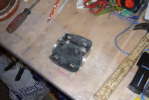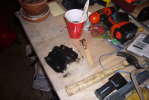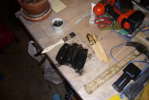Preparing the boom
posted 2008 January 28
Time to get back in the saddle.
The first thing to do (which I'd been putting off a long time) was to paint the forestay fitting with three coats of epoxy/207, to provide a bit of UV protection. The first problem was how to stop epoxy from getting in the holes (why I'd been putting it off). Bill had special plastic parts he fit into the holes, but Greg just said "use tape", so I taped it all up, including special circular and oval dots to go over the holes where the tubing is. When I first did this, I used blue painter's tape - but then realized that the epoxy likes to stick to that stuff, and this tape would work better.
Then three coats of epoxy/207/graphite: one, two, three. The fitting could use a light sanding and some varnish, but I don't want to open a (new) can of varnish. So this will have to do. Besides, it will mostly be under the spinnaker sock.
Next, I measured, drilled and cut the hole for the re-enforcing tube for the primaries. I drilled a smaller pilot hole using a standard drill bit, then etched out the size of the hole I wanted using a drafting template (after very careful triple-measurement). I then expanded the initial hole with a dremel grinder, to keep carbon splitering to a minimum. I tried sanding down the tube so it was perfectly circular, but then just cut the hole to fit (the tube was pretty circular as it was). It wasn't perfectly straight through, but close enough.
Next, I sanded the end of the spinnaker pole, so I can wrap it in a couple wraps of tape - this strengthens it for the block. I also traced out a 2” wide stripe on the boom where the reinforcing graphite tape should be applied. I traced this at a 45° angle; in retrospect it could have been 30° or similar. 45° is hard to bond the tape on, it wants to slide forward. Sand, and it's ready for bonding. Wrap with tape, paint with epoxy (with a bit of graphite mixed in), wrap in peel ply, mylar, and let cure. The boom was supposed to have a single 2” wide strip of carbon tape, but all I had was 1 1/2” - so two overlapping layers would have to do. Not quite as nice, but good enough.
With the excess epoxy, I bonded the tube in the mast. I filled a syringe and squirted it around the edge, then pulled the covered part into the tube, and squirted more into whatever gaps I could see (not much of one).
Next was to bond the mainsheet platform onto the boom. Measure (the platform is 24” back from the leading edge of the boom, as is the middle of the angled tape; the hole is centred top-to-bottom). Sand, sand the cleat base, drill two holes in the bottom of the boom where the cleat base attaches (this part was hard, it's tricky to find the exact centre of the bottom of the boom). Mix up the epoxy, put it into a ziploc baggie, and squeeze it out in a nice thick line in the middle. Worked perfectly. To ensure there was room for the bolt holes, at the leading and trailing edges the fillet isn't quite as large. Once it's positioned correctly, rivet the mainsheet plate in place - two rivets on the bottom. All done.
Once that cured, I installed the mandrels on either side of the boom. Sanded the mandrels down so they're not razor sharp, and rough up the sides of the boom and base. Use the old ziploc trick again, and press in place. To make a nice U shaped fillet on the inside of the fitting, I pulled a pencil along the inner edge. (A washer screwed on the end of a dowel would have worked as well.)
Finally, with some of the excess, I filled the bottom edge of the end of the boom.
| (25 images) | |||
|


